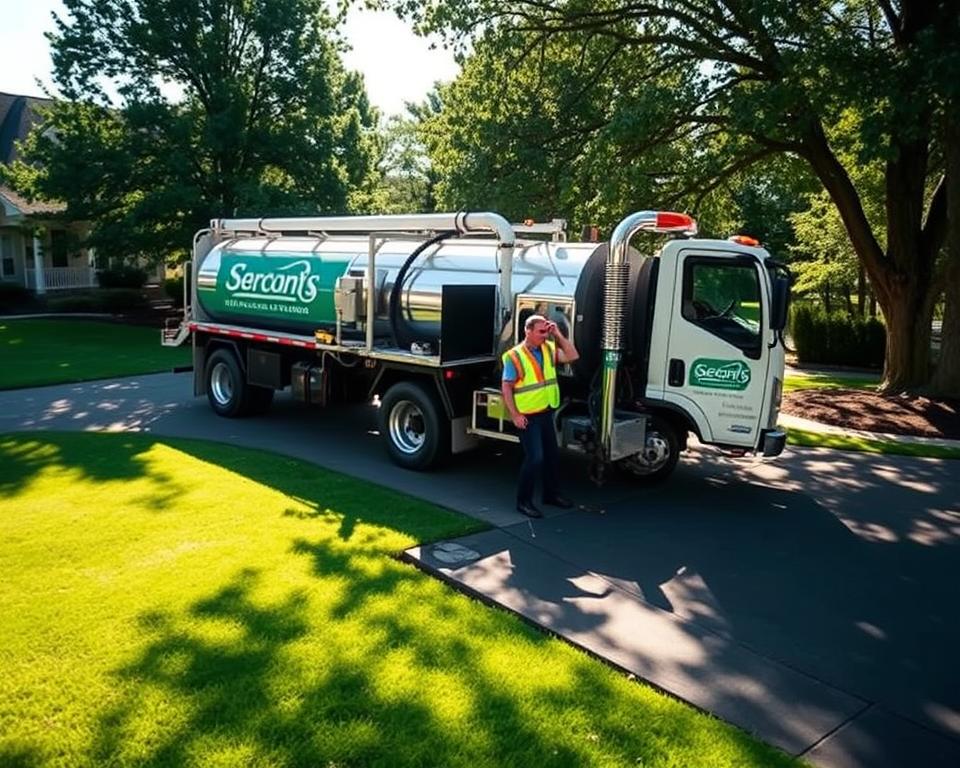Septic Tank Pumping Price Overview
Have you wondered about the true expense of maintaining your septic system current, or if you’re spending more than necessary? It’s critical for householders to grasp the specifics of septic tank pumping prices. On average, the price tag sits near $420, however it can range significantly. This spread comes from variables like your system’s capacity and where you live – septic system pumping.
Scheduled servicing of your septic tank avoids costly repairs, underscoring the importance of knowing service costs. We aim to dive into septic tank service pricing thoroughly. This will allow you to budget cost‑effectively for your system’s upkeep.
Major Highlights
- Average septic tank pumping runs about $420.
- Prices can range between $290 USD and $560 based on various conditions.
- Regular maintenance helps avoid more expensive repairs later on.
- Most households need pumping every three to five years.
- Number of occupants and consumption can impact pumping interval.
Recognizing the Value of Septic Tank Pumping
Septic tank pumping is essential for a well‑functioning wastewater system. It removes solids that, if not addressed, cause blockages. Consistent pumping doesn’t just avoids bad smells but also fends off steep repair costs.
Ignoring septic tank maintenance can compromise our common dependence on these systems. Luckily, cost‑effective services minimize the risk of system failure. Routine upkeep extends your septic system’s life, guaranteeing trouble‑free operation.
Fee information for septic tank upkeep teaches the value of forward‑thinking care. Regular service detects problems at an initial stage, avoiding major damage and steep repair bills. Regular pumping is a prudent move for homeowners to secure their asset and ensure peace of mind.
Typical Prices for Septic Tank Pumping
Septic tank pumping generally falls between $250 and $600 in cost. In most cases, homeowners will spend about $400 for this critical service. Cost swings are due to variables like tank size, geographic setting, and how often maintenance is performed. Common tanks, around a thousand gallons, usually cost between $225 USD and $400.
Homeowners should recognize the importance of setting aside funds every three to five years for septic tank cleaning. This regular care is based on the tank’s usage and size. It helps avert larger, pricier issues in the long run, showing to be both time and budget friendly.

Factors Influencing Septic Tank Pumping Prices
Multiple factors are important in determining the cost of septic tank pumping. Knowing these details enables homeowners to plan for these necessary services wisely.
The capacity is significant immensely. Larger tanks require more work and time to empty, which results in higher fees. The ease of access to your tank also greatly affects the price. Tanks set far underground or in hard‑to‑reach locations necessitate more time and special tools from technicians, thus boosting the labor costs.
Costs can swing widely according to where you live. This is due to shifts in local labor rates and waste‑processing costs. For example, some areas impose higher charges for disposing of waste, impacting the total service cost. Moreover, tanks with significant solid waste accumulation also see additional fees—anywhere from $100 to $300. Plus, the more frequently a tank needs pumping—due to higher water usage—the higher the ongoing expenses.
Septic Tank Size and Its Effect on Cost
The volume of your septic tank strongly influences the cost of its upkeep. Smaller tanks, say, those that can hold 750 gallons, typically have lower pumping costs, commonly ranging from $175 to $300. On the other hand, bigger tanks, capable of holding up to one thousand seven hundred fifty gallons, may incur charges between $400 and $700. The majority of single‑family residences feature tanks that hold between 1,000 to 1,250 gallons, providing a blend between capacity and function.
Homes with smaller tanks or large households often require more frequent pumping services, which improves the overall expense. It’s vital to conduct regular septic tank inspections in these situations. This makes sure the tank does not overflow or break down, which sidesteps additional problems. By recognizing the connection between tank size and service fees, homeowners can make smart choices regarding their septic systems and their upkeep demands.
Geographic Variations in Septic Tank Pumping Costs
Septic tank pumping costs can vary dramatically based on region. In urban areas, the expenses are frequently higher due to local septic services having increased overhead. For example, Minneapolis, MN residents may spend between $180 USD and $280, while those in Portland, OR could see prices from $440 to $750.
The reasons behind these gaps are multifaceted. They include regional expenses, need for septic specialists, and local regulations. In places where septic services are limited, homeowners might incur higher charges due to the lack of options. Moreover, stringent regulations in some regions can increase the need for higher compliance fees, impacting the cost of services.
Being knowledgeable about these geographic cost variances is crucial for homeowners. It enables them to forecast their septic maintenance spending more precisely. By recognizing local pricing, they can get quotes from specialists prudently, caring for their septic system efficiently without overspending.
Extra Expenses to Consider with Septic Tank Pumping
Homeowners often fail to consider various additional maintenance costs linked to septic tank pumping. The core cost covers just the standard service, leaving out other potential expenses. Understanding these can aid in creating a complete budget.
CCTV inspections, for instance, fall between $250 to $500 USD. They offer a non‑invasive look into the system’s condition. Additionally, filter rinsing, which if ignored can create system failures, represents another cost.
The range for repairs can be large, from $100 to $4,000, depending on the specific issues. This variability underscores the need of factoring in additional maintenance costs for future budgeting.
Allocating Funds for Septic Tank Maintenance
When planning for septic tank care, it’s vital to adopt a comprehensive view. This covers multiple critical elements. Due to variable factors, the cost of maintenance can change considerably. Therefore, proper financial planning is essential.
To ensure your system runs efficiently and to sidestep surprise bills, keep these periods and services in mind:
- Routine pumping: This service is typically required every 3–5 years.
- Inspections: Budget for around $250 USD to $1,180 for inspections every three years.
- Potential repairs: Set aside a fund for unexpected fixes, which can arise unexpectedly.
Creating a regular maintenance calendar with a trusted septic service is essential. By anticipating these expenses, homeowners can evade the large costs tied to neglect. This strategy secures the durability and performance of their septic systems.
Common Signs That Your Septic Tank Needs Pumping
Keeping watch to your septic system’s condition is important. Identify the early signs that suggest your septic tank is due for pumping. Doing so can avert serious damage and reduce repair costs.
- Slow drains: Water that drains slowly in sinks, tubs, or toilets could indicate your septic tank is at capacity.
- Unpleasant odors: Bad smells around the septic tank or in your yard are frequently clear indicators of a problem.
- Gurgling sounds: Strange gurgling from your plumbing might suggest air is trapped because of a blockage.
- Wet spots: Soggy areas or lush grass patches near the drain field signal waste seepage from the tank.
- Dark green grass: Grass that is darker and appears robust around the drain field may indicate leakage of nutrients, hinting at an issue.
Regular checks by septic system specialists can ensure your tank is in good shape. Using seasoned septic technicians for maintenance prevents these issues, ensuring your system’s longevity.
Gains of Regular Septic Tank Inspections
Regular inspections are integral to keeping your septic system in top condition. They identify potential problems before they become major repairs. By hiring professionals for these checks, every part of your system undergoes a thorough assessment.
The process looks at various parts of your system, including waste levels and the drain field’s state. It ensures that critical parts, like baffles, operate as they should. Spotting issues sooner prevents harmful overflows and shields the environment, aiding both your home and the wider community.
Getting your septic tank checked every three years can save you a lot of money. It stops bigger issues from arising due to neglect. This not only saves on repair costs but also secures your peace of mind.
| Inspection Aspect | Importance |
|---|---|
| Waste Level Assessment | Prevents overflow and backups |
| Drain Field Evaluation | Identifies saturation and function |
| Component Functionality Check | Ensures proper system operation |
| Early Problem Detection | Saves on repair costs |
Ways to Reduce Spending on Septic Tank Pumping Prices
Homeowners aiming to cut septic tank pumping costs have several strategic options. Organizing group services with neighbors is one efficient method. This involves coordinating with others nearby to book services as a group, potentially landing group discounts. It’s a way to strengthen community bonds while controlling expenses more effectively.
Another practical approach is to join maintenance plans with septic service providers. These plans often include reduced rates for routine check‑ups and pumpings, keeping septic systems working properly at a lower cost. Homeowners are urged to ask about these plans when contacting service companies.
Making the septic tank easy to reach can also help reduce pumping expenses. Good accessibility means there’s no requirement for extra labor charges. It’s wise to keep the area around the tank clear of clutter, allowing for straightforward servicing.
Practicing certain habits helps in extending the time between pumpings as well. Reducing water usage and limiting garbage disposal use are key practices. These actions can significantly boost septic system health, lowering the need for regular maintenance. By implementing these habits, homeowners can successfully trim their septic tank pumping costs, protecting their finances and systems.
As a Final Point
Guaranteeing consistent septic tank pumping is essential for homeowners who want to keep their waste management system efficient and efficient. Being informed about the costs involved enables effective budgeting. This way, you can secure cost‑effective septic services without sacrificing your system’s functionality.
Embracing a proactive approach to maintenance is very advantageous. By watching for signs that signal the need for pumping, you can dodge hefty repairs and lengthen your system’s lifespan. Such actions not only improve your home’s functionality but also provide you peace of mind.
Ultimately, staying on top of regular inspections and timely septic tank pumping is vital for efficient home maintenance. By giving importance to proper planning and seeking out affordable septic service, you’ll secure your septic system remains functional and effective for many years.

